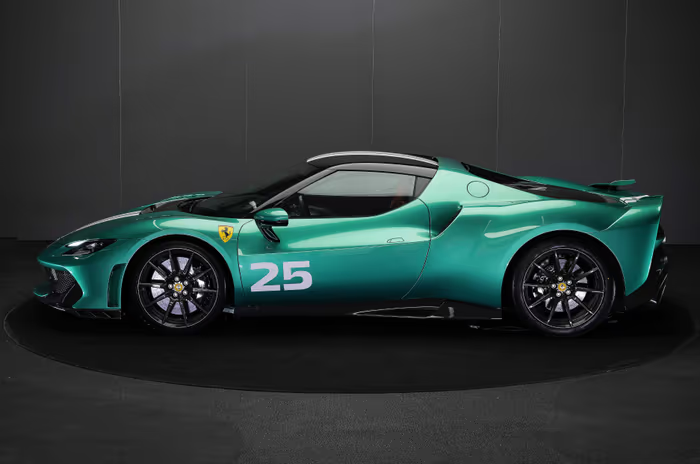Ferrari has just unveiled the new 296 Speciale Coupe and Aperta, which join an iconic lineage of special edition Ferrari berlinettas, following in the footsteps of the Challenge Stradale, 430 Scuderia, 458 Speciale and 488 Pista – cars that have earned reputations for not only increased performance but also their heightened driving involvement.
Like its predecessors, the 296 Speciale builds on the standard car – in this case, the 296 GTB – by increasing power, reducing weight and adding track-focused upgrades. The result is a car aimed squarely at the brand’s most committed drivers.
- Ferrari 296 Speciale is the first V6 plug-in hybrid in the special edition series
- Produces 50hp more power and is 60kg lighter than regular 296 GTB
- Customer deliveries to begin in the first quarter of 2026
Ferrari 296 Speciale: the headlining numbers
Most powerful rear-wheel-drive Ferrari road car ever
Total power has increased to 880hp, a 50hp gain over the GTB, making it the most powerful rear-wheel-drive Ferrari road car to date. Aerodynamic changes are equally significant. Downforce is up 20 percent compared to the GTB, with 435kg generated at 250kph. Weight reduction has been another major focus. At 60kg lighter than the GTB, the 296 Speciale features carbon-fibre bodywork, titanium engine parts and a pared-down interior. The result is a weight of just 1,410kg (coupe), which translates to a class-leading power-to-weight ratio of 1.6kg per horsepower – again, a record for a rear-drive Ferrari.
The Speciale produces 20 percent more downforce than the regular 296 GTB.
More importantly, the company says this is their best expression of ‘driving fun’, having pushed the limits with five key aspects of the car – lateral grip, acceleration, gear shifts, braking and, crucially, the sound.
Arriving four years after the regular 296, the latest Ferrari special edition is also called the ‘Speciale’, just like the 458 from two generations ago. Ferrari says that’s what its fans called this model when it was under development, and so the brand chose to stick to it and make the ‘Speciale’ moniker official.
Ferrari 296 Speciale engine and specs
V6 plug-in hybrid is 9kg lighter, gets extra boost in ‘Qualify’ mode
| Ferrari 296 Speciale specs | |
|---|---|
| Engine | 3.0-litre, twin-turbocharged V6 |
| Electric motor | Dual-rotor, central-stator axial flux motor |
| Engine power output | 700hp |
| Electric motor output | Up to 180hp |
| Combined power output | Up to 880hp |
| Gearbox | 8-speed dual-clutch |
| Drive configuration | Rear-wheel drive |
| Weight | 1410kg (Coupe) |
| Power to weight ratio | 1.60kg/hp |
| Battery | 7.45kWh |
| Electric-only range | 25km |
| 0-100kph (claimed) | 2.8 seconds |
| 0-200kph (claimed) | 7 seconds |
The hybrid powertrain continues to pair a 3.0-litre twin-turbo V6 with an electric motor, but both components have been significantly uprated. The electric motor now develops 315Nm and up to 180hp when the eManettino switch on the steering wheel is set to ‘Qualify’. This “Extra Boost” function delivers a surge of torque between gear shifts, which, in turn, has allowed Ferrari to retune the 8-speed dual-clutch gearbox for faster, harder shifts that hit with even greater immediacy.
The V6 engine retains its distinctive 120-degree architecture and hot-vee configuration, with the turbos tucked within the cylinder banks for a more compact and responsive setup. The combustion engine alone now produces 700hp – a 37hp increase over the regular 296 GTB – courtesy of race-bred upgrades from the one-make 296 Challenge series. These include titanium con-rods, a lighter crankshaft and stronger pistons, while a Formula 1-derived knock-control system lets the engine run closer to its limits safely.
Ferrari claims the 296 GTB can sprint from 0 to 100kph in 2.8 seconds (0.1 seconds faster than the regular 296), and 0 to 200kph comes up in an astonishing 7 seconds.
The electric motor, mounted between the engine and the gearbox, also recharges the 7.45kWh high-voltage battery, starts the internal combustion engine and enables an electric-only range of up to 25km. A dedicated clutch decouples the motor from the engine to seamlessly switch between four drive modes: eDrive, Hybrid, Performance and Qualify.
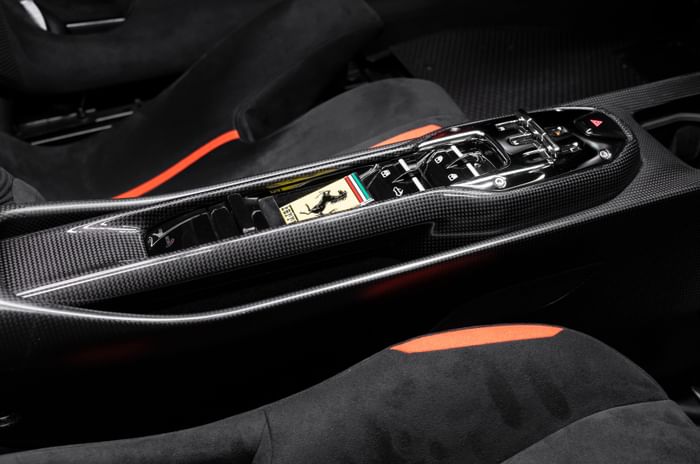
Carbon-fibre centre console gets the iconic ‘shift gate’ element for the 8-speed DCT.
Weight-saving measures extend to the powertrain, which is around 9kg lighter than in the standard 296 GTB. Much of this comes from the adoption of titanium connecting rods (shared with the LaFerrari), a lighter crankshaft, redesigned turbochargers, and stronger, lighter pistons. Ferrari has also increased the compression ratio by 7 percent and further optimised cooling, drawing heavily from lessons learned in the 296 Challenge and 499P race programmes.
Finally, the exhaust retains the equal-length headers and single tailpipe layout of the regular 296, but it now benefits from new acoustic ducts that amplify higher frequencies, giving the Speciale an even more thrilling soundtrack at high revs.
Ferrari 296 Speciale aerodynamics and cooling
Aerodynamics derived from 296 Challenge and FXX K race cars
The bodywork and aero changes are most apparent at the rear, where the 296 Speciale has a completely new aerodynamic profile. New vertical fins at the bumper’s edges optimise wake management and reduce drag; it also curves upwards, with the profile of the horizontal surface generating additional downforce. These aerodynamic elements have been derived from the 296 Challenge and the FXX K, respectively, and incorporated into a single unit here.
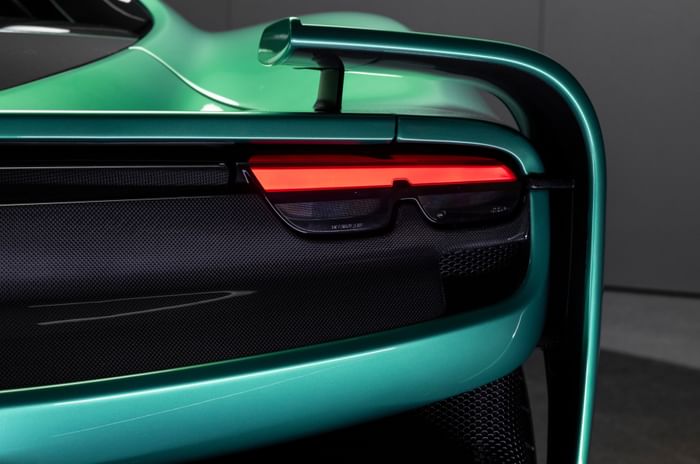
The rear vertical fins are the most distinctive aerodynamic element on the 296 Speciale.
These new side winglets work in conjunction with the active central spoiler that now gets a much faster actuator to transition between the high and low downforce configurations. There’s also a new “medium downforce” setting to bridge the gap between drag reduction and full downforce. The rear diffuser and underbody venturi tunnels have also been enhanced for improved downforce.
At the front, the bonnet has a new duct that helps channel air from under the body to over the body – again, a feature derived from the 296 Challenge. Also, there are additional louvres on the sides, aero fins on the bumper’s edges and a much more prominent splitter to optimise airflow around and under the car.
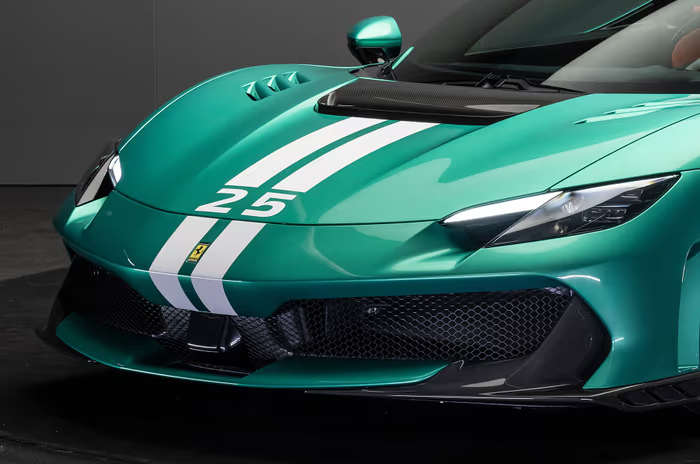
Air intakes on the front bumper have been enlarged by 12 percent for improved cooling.
For the additional power, the 296 Speciale also needed additional cooling. Ferrari has put in a lot of work to take the heat out without increasing the size of the radiators. For this, it enlarged the air intakes on the new front bumper by 12 percent, eliminated the central aperture in the front undertray and relocated the lateral louvres further to the sides. Ferrari has also increased the size of the air ducts that are incorporated in the headlamps and channel air to the brakes, thereby improving its cooling performance as well.
Ferrari 296 Speciale suspension and braking
Stiffer suspension setup, 5mm lower ride height
The 296 Speciale uses new shock absorbers derived from the 296 GT3 and titanium springs to minimise overall weight. The spring and damper settings have been revised, so the car rides 5mm lower than the regular 296 GTB. However, this has helped reduce the maximum roll angle when cornering by 13 percent, thereby improving the car’s handling at the limit. One can opt for a suspension-lift system for use on poor roads.
As for braking, the Speciale uses what Ferrari calls the ABS Evo controller system. The system essentially uses various sensors to ascertain the car’s effective speed with great precision, which is then used to determine a target slippage value for each wheel and optimise brake force distribution more effectively.
Ferrari 296 Speciale: exterior and interior
Design is guided by aerodynamic and weight-saving needs
As detailed above, the styling of the 296 Speciale is largely guided by its aerodynamic and performance needs. The front bonnet is more sculpted, the bumper has a long, suspended splitter, and there are additional wing elements at the bumper’s edges. Then, there are the louvres on sides of the bonnet – these have become a signature of the Ferrari special edition models. At the rear, the new side winglets aside, the 296 Speciale also gets a broad, black carbon-fibre strip incorporating the tail-lights. The engine cover at the rear gets a darkened finish and is concealed by a metal mesh. There’s a new five-spoke dual-tone design for the alloy wheels.
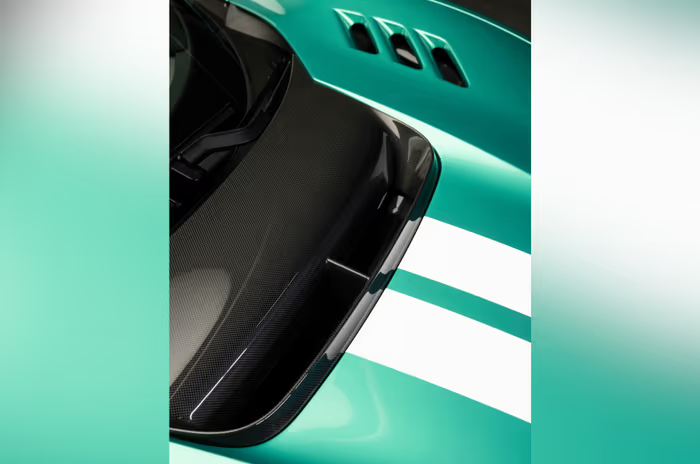
The bonnet duct helps channel air from under the car to over the body.
Additionally, to save some more weight, customers can opt for the front and rear bumpers, the engine compartment and the alloy wheels to be finished in carbon fibre. Ferrari is also offering a bespoke new Verde Nürburgring exterior paint shade, which can be had with one or two racing stripes extending the car’s length, along with a racing number of choice from 00 to 99.
The interior of the 296 Speciale will be familiar from any modern Ferrari, except that it is extensively trimmed in carbon fibre and Alcantara. Ferrari has revised the door trim, which is now made from a single block of carbon-fibre and has a more minimalistic design. The centre console, too, is completely made of carbon fibre and has a raised surface for the controls. It also gets racing bucket seats with a four-point harness (the Aperta gets a three-point harness).

Interior gets new racing bucket seats with four-point harness.
Ferrari 296 Speciale launch details
Launches in Q1 of 2026
The Ferrari 296 Speciale Coupe and Aperta will be limited – not to the number of units manufactured but the duration for which they are produced. Ferrari will officially launch the 296 Speciale Coupe globally in the first quarter of 2026, followed by the Aperta about three months later in the second quarter. It is not clear when the 296 Speciale versions will come to India, but that’s likely to be towards the end of 2026.
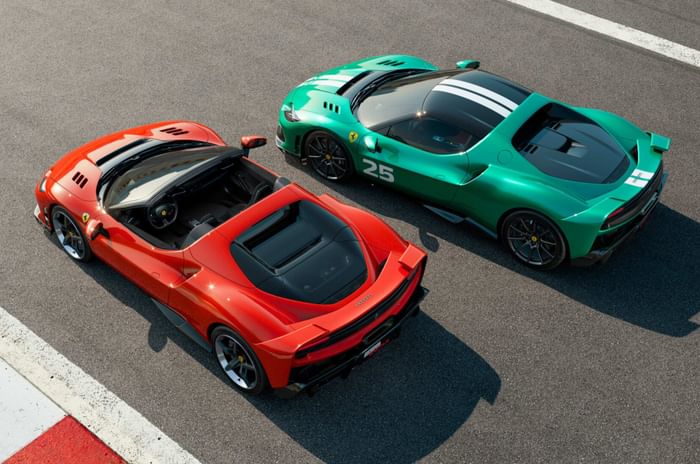
While Ferrari’s regular road cars have become increasingly powerful and complex, its track-focused specials have always been the ones to deliver the purest thrills. From the 360 Challenge Stradale to the 488 Pista, these models have consistently raised the bar for engagement and agility. On paper, the 296 Speciale looks set to do the same – with the added challenge of doing so in a new hybrid era.
With inputs from Saptarshi Mondal
Also See:



